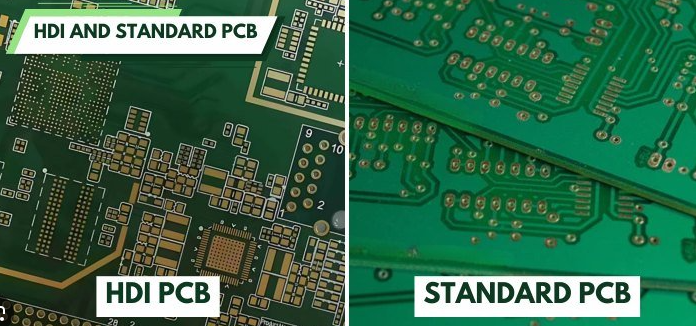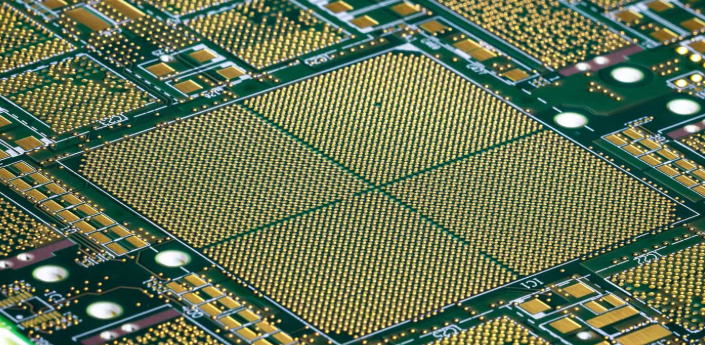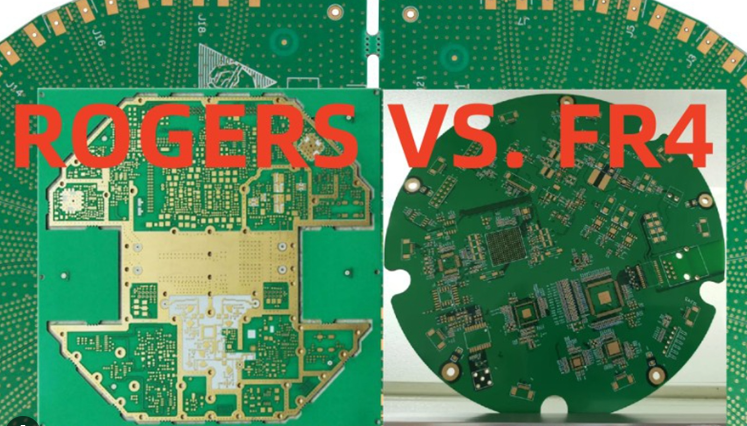If you're looking for a reliable solution for compact, high-performance electronics, High Density Interconnect (HDI) PCBs are the answer. These advanced circuit boards offer tighter wiring density, smaller vias, and enhanced signal integrity compared to traditional PCBs. In partnership with industry leaders like NCAB Group, ALLPCB ensures access to top-quality HDI PCB manufacturing tailored to your needs, whether you're using materials like Rogers or FR4 standard for any layer configuration. In this blog, we'll dive deep into the world of HDI PCBs, exploring their benefits, design considerations, material choices, and manufacturing processes to help you make informed decisions for your next project.
What Are HDI PCBs and Why Are They Important?
High Density Interconnect (HDI) PCBs are a type of printed circuit board designed to accommodate a higher number of components in a smaller space. Unlike conventional PCBs, HDI boards feature finer lines, smaller vias (often microvias), and denser wiring per unit area. This technology is crucial for modern electronics, such as smartphones, tablets, medical devices, and automotive systems, where size and performance are critical.
The importance of HDI PCBs lies in their ability to support miniaturization without sacrificing functionality. With HDI, you can achieve better signal integrity, reduced electromagnetic interference (EMI), and improved thermal management. These boards are often built with advanced materials like Rogers for high-frequency applications or FR4 standard for cost-effective solutions, and they can be designed with any layer count to meet specific project demands.

Key Benefits of HDI PCBs for Modern Electronics
HDI PCBs bring several advantages to the table, making them a go-to choice for engineers working on cutting-edge technology. Here are some of the standout benefits:
- Compact Design: HDI boards allow for more components to be packed into a smaller footprint, reducing the overall size of the device. This is especially valuable in wearable tech and portable gadgets.
- Improved Signal Integrity: With shorter interconnects and reduced parasitic effects, HDI PCBs minimize signal loss and crosstalk. For high-speed applications, this can mean achieving signal speeds up to 10 Gbps or higher with minimal distortion.
- Enhanced Reliability: The use of microvias and advanced materials reduces the risk of failure, even under harsh conditions. This is critical for industries like aerospace and automotive, where reliability is non-negotiable.
- Flexibility in Layer Count: HDI technology supports any layer configuration, from simple 4-layer boards to complex 16-layer or higher designs, offering versatility for various applications.

Material Choices: Rogers vs. FR4 Standard for HDI PCBs
Choosing the right material for your HDI PCB is a critical decision that impacts performance, cost, and manufacturability. Two popular options are Rogers and FR4 standard, each with distinct characteristics suited for different applications.
Rogers Material for High-Frequency Needs
Rogers materials are often selected for HDI PCBs in high-frequency and high-speed applications. These laminates offer low dielectric loss, stable dielectric constant (Dk values typically between 2.2 and 10.2), and excellent thermal stability. They are ideal for RF, microwave, and 5G applications where signal integrity at frequencies above 1 GHz is essential. For instance, Rogers 4350B is a common choice for boards requiring controlled impedance of 50 ohms with minimal signal degradation.
While Rogers materials provide superior performance, they come at a higher cost. Engineers must weigh the benefits against budget constraints, especially for projects where high-frequency performance is not a primary concern.
FR4 Standard for Cost-Effective Solutions
FR4 standard is the most widely used material for PCBs, including HDI designs, due to its affordability and versatility. With a dielectric constant around 4.5, FR4 is suitable for many general-purpose applications, including consumer electronics and industrial controls. It supports multilayer configurations and can handle moderate frequencies, though it may not perform as well as Rogers in high-speed or high-frequency scenarios due to higher signal loss.
For projects requiring any layer count without extreme performance demands, FR4 remains a reliable and budget-friendly option. Its thermal and mechanical properties also make it a durable choice for many environments.

Design Considerations for HDI PCBs with Any Layer Configuration
Designing an HDI PCB requires careful planning to ensure functionality and manufacturability, especially when dealing with any layer count. Here are some key considerations to keep in mind:
Via Technology and Stackup Planning
HDI PCBs often use microvias (diameters typically below 150 microns) instead of traditional through-hole vias. These smaller vias save space and allow for denser routing. There are different types of microvias, such as blind vias (connecting an outer layer to an inner layer) and buried vias (connecting inner layers only), which can be stacked or staggered depending on the design.
A well-planned stackup is essential for maintaining signal integrity and controlling impedance. For a 6-layer HDI board, a common stackup might include two signal layers on the top and bottom, with ground and power planes in the middle to reduce EMI. Advanced designs with 12 or more layers might incorporate multiple ground planes to further isolate high-speed signals.
Trace Width and Spacing
In HDI designs, trace widths and spacing are much finer than in standard PCBs. Typical trace widths can be as narrow as 3 mils (0.076 mm), and spacing might be reduced to 3 mils or less. This allows for higher wiring density but requires precision in manufacturing to avoid shorts or signal interference. Designers must also account for the current-carrying capacity of these narrow traces, often using tools to simulate thermal performance under loads up to 2 amps or more.
Thermal Management
With components packed closely together, heat dissipation becomes a challenge in HDI PCBs. Incorporating thermal vias and selecting materials with high thermal conductivity (like certain Rogers laminates with thermal conductivity up to 1.0 W/mK) can help manage heat. For FR4-based designs, additional copper planes may be used to spread heat evenly across the board.
Manufacturing HDI PCBs: Challenges and Solutions
Producing HDI PCBs is more complex than manufacturing traditional boards due to the precision required for fine features and multilayer structures. Here are some common challenges and how they are addressed:
- Microvia Reliability: Drilling and filling microvias with diameters as small as 100 microns can lead to defects if not done correctly. Advanced laser drilling technology ensures precise via formation, while proper plating processes prevent voids or cracks.
- Layer Alignment: In boards with any layer count, misalignment during lamination can cause signal issues. High-precision equipment and strict quality control measures are used to maintain alignment within tolerances of ±0.05 mm.
- Material Compatibility: Mixing materials like Rogers and FR4 in hybrid designs requires careful consideration of thermal expansion rates (CTE values often range from 13-17 ppm/°C for FR4 and 10-14 ppm/°C for Rogers) to avoid delamination during assembly.
Partnering with experienced manufacturers ensures these challenges are met with the right expertise and technology, resulting in high-quality HDI PCBs that meet stringent standards.
How NCAB Group Enhances HDI PCB Production
NCAB Group stands out as a leader in the PCB industry, offering specialized support for HDI PCB projects. Their focus on quality, sustainability, and supply chain management ensures that engineers receive boards that meet exact specifications. With a global network of manufacturing partners, NCAB Group provides access to advanced HDI technologies, whether you need Rogers materials for high-frequency designs or FR4 standard for cost-effective solutions.
Their expertise in managing complex, multilayer HDI designs with any layer configuration helps streamline the production process. From initial design consultation to final delivery, NCAB Group's commitment to precision and reliability makes them a trusted partner for cutting-edge electronics projects.
Applications of HDI PCBs Across Industries
HDI PCBs are used in a wide range of industries due to their ability to support compact, high-performance designs. Some key applications include:
- Consumer Electronics: Smartphones, tablets, and wearables rely on HDI technology to pack powerful components into tiny spaces.
- Automotive: Advanced driver-assistance systems (ADAS) and electric vehicle controls use HDI PCBs for reliable, high-speed data processing.
- Medical Devices: Compact diagnostic tools and implantable devices benefit from the small size and reliability of HDI boards.
- Telecommunications: 5G infrastructure and networking equipment often use Rogers-based HDI PCBs to handle high-frequency signals with minimal loss.
Conclusion: Why Choose HDI PCBs for Your Next Project?
HDI PCBs are a game-changer for engineers looking to design smaller, faster, and more reliable electronics. With benefits like improved signal integrity, compact design, and flexibility in material choices like Rogers or FR4 standard, these boards are ideal for a wide range of applications. Whether you need a simple 4-layer board or a complex design with any layer configuration, HDI technology delivers the performance you need.
By partnering with ALLPCB and leveraging the expertise of NCAB Group, you gain access to top-tier HDI PCB manufacturing tailored to your specifications. From design to delivery, the focus remains on quality and precision, ensuring your project succeeds in today’s competitive market. Start exploring the possibilities of HDI PCBs and take your electronics design to the next level.



